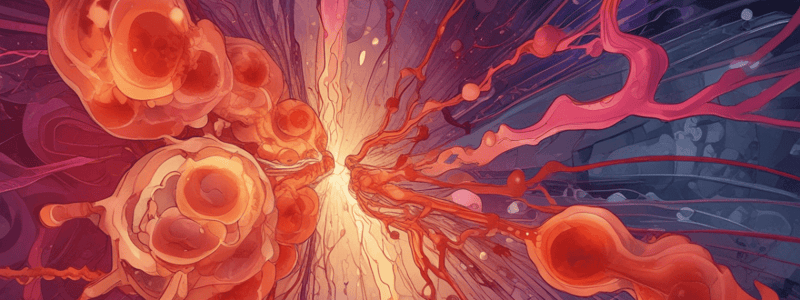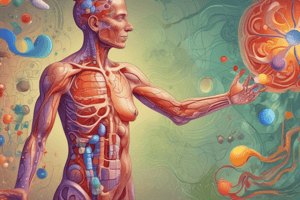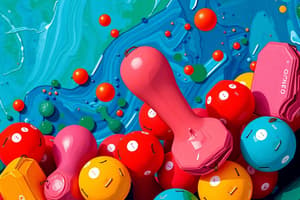Podcast
Questions and Answers
What is the primary outcome of the inflammation process?
What is the primary outcome of the inflammation process?
- Immune system suppression
- Cellular differentiation
- Tissue damage and repair (correct)
- Hormone regulation
Which of the following molecules are generated by cyclooxygenase?
Which of the following molecules are generated by cyclooxygenase?
- Leukotriene
- Steroid
- Prostaglandin (correct)
- Histamine
What is the primary goal of acute inflammation?
What is the primary goal of acute inflammation?
- To recruit immune cells to aid healing (correct)
- To initiate repair
- To eliminate pathogens and limit their spread
- To cause tissue damage and fibrosis
What is the main reason for the increase in blood flow to the affected area during inflammation?
What is the main reason for the increase in blood flow to the affected area during inflammation?
What is the result of the compromise in basement membrane integrity during inflammation?
What is the result of the compromise in basement membrane integrity during inflammation?
What is the role of prostaglandins and histamine in inflammation?
What is the role of prostaglandins and histamine in inflammation?
What is the result of frequent and repetitive release of inflammatory mediators?
What is the result of frequent and repetitive release of inflammatory mediators?
What is the primary mechanism by which leukocytes are recruited to the damage site during inflammation?
What is the primary mechanism by which leukocytes are recruited to the damage site during inflammation?
What is the primary product of the cyclooxygenase reaction in the arachidonic acid pathway?
What is the primary product of the cyclooxygenase reaction in the arachidonic acid pathway?
What is the primary function of leukotriene receptors?
What is the primary function of leukotriene receptors?
What is the primary difference between prostaglandin receptors and leukotriene receptors?
What is the primary difference between prostaglandin receptors and leukotriene receptors?
The main goal of acute inflammation is to prevent tissue repair.
The main goal of acute inflammation is to prevent tissue repair.
Prostaglandins and histamine reduce pain during inflammation.
Prostaglandins and histamine reduce pain during inflammation.
Vasodilation decreases blood flow to the affected area during inflammation.
Vasodilation decreases blood flow to the affected area during inflammation.
Chronic inflammation can lead to fibrosis of the tissue through frequent and repetitive release of inflammatory mediators.
Chronic inflammation can lead to fibrosis of the tissue through frequent and repetitive release of inflammatory mediators.
Macrophages are mobilized during Phase 2 of inflammation.
Macrophages are mobilized during Phase 2 of inflammation.
The five cardinal signs of inflammation do not include loss of function.
The five cardinal signs of inflammation do not include loss of function.
All prostaglandin receptors are G-protein coupled receptors that regulate cAMP and/or Ca2+ ions.
All prostaglandin receptors are G-protein coupled receptors that regulate cAMP and/or Ca2+ ions.
The PGI2 receptor is Gi/q coupled.
The PGI2 receptor is Gi/q coupled.
Leukotriene receptors are only expressed on cells that surround the tissues where leukotrienes are made.
Leukotriene receptors are only expressed on cells that surround the tissues where leukotrienes are made.
Cysteinyl leukotrienes are involved in homeostatic functions.
Cysteinyl leukotrienes are involved in homeostatic functions.
The cyclooxygenase reaction in the arachidonic acid pathway produces PGF2.
The cyclooxygenase reaction in the arachidonic acid pathway produces PGF2.
All prostaglandins cause bronchoconstriction.
All prostaglandins cause bronchoconstriction.
Study Notes
Inflammation
- Inflammation mobilizes defensive cells, limits the spread of pathogens, kills pathogens, and initiates repair.
- The process of inflammation consists of three phases:
- Phase 1: Exudation of plasma fluid containing mediators
- Phase 2: Neutrophils
- Phase 3: Monocytes differentiate to macrophages
- Clearance occurs through the lymphatic system.
- Anti-inflammatory mediators are involved in acute inflammation, tissue damage, histamine release, and recruitment of immune cells.
Prostaglandins
- Prostaglandins are derived from the arachidonic acid pathway.
- The pathway involves the following steps:
- Phospholipase A2 converts phospholipid into arachidonic acid
- Cyclooxygenase (COX) converts arachidonic acid into prostaglandin G2
- Prostaglandin G2 is converted into prostaglandin H2 by peroxidase reaction
- Prostaglandins cause:
- Vasodilation
- Pain
- Fever
- Prostaglandin receptors:
- All are G-protein coupled receptors (GPRCs)
- Most regulate cAMP
- PGE2 has the greatest number of receptors: 2x Gs, 1x Gi/q, and 1x Gq
- Homeostatic and inflammatory functions
- PGI2 receptor is Gs coupled
Leukotrienes
- Leukotrienes are derived from the arachidonic acid pathway.
- Leukotriene synthesis involves the conversion of arachidonic acid into leukotriene A4.
- Leukotrienes cause:
- Bronchoconstriction
- Increase in vascular permeability
- Chemotaxis
- Leukotriene receptors:
- All are G-protein coupled receptors (GPRCs)
- On cells that surround the tissues where leukotrienes are made
- All cells express B2 receptor
- No homeostatic function, only inflammation with a broad response
Inflammatory Mediators
- Inflammatory mediators:
- Attract leukocytes
- Leukocytes remove the problem
- Acute inflammation aims to recruit cells to aid healing mainly by chemotaxis
- Frequent and repetitive release of inflammatory mediators can lead to chronic inflammation, which may eventually lead to fibrosis of the tissue
5 Cardinal Signs of Inflammation
- The 5 cardinal signs of inflammation are:
- Heat
- Redness
- Swelling
- Pain
- Loss of function
- These signs can be explained by the following concepts:
- Vasodilation increases blood flow to the area
- Extravasation of leukocytes into the surrounding tissue
- Proteins in the extra cellular fluid (ECF) lead to water moving into ECF by osmosis
- Release of prostaglandins and histamine activate neurons → pain
Studying That Suits You
Use AI to generate personalized quizzes and flashcards to suit your learning preferences.
Related Documents
Description
This quiz covers the process and effects of inflammation, the role of cyclooxygenase, prostaglandins, leukotrienes, histamine, and steroids in combating inflammation, and the receptor systems for these molecules. It also discusses the causes, effects, and treatment of gout.




